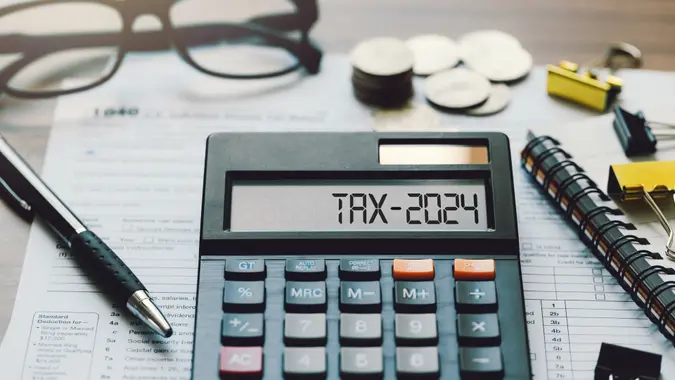Now That You’re Divorced, Who Claims Your Child on Taxes?
Commitment to Our Readers
GOBankingRates' editorial team is committed to bringing you unbiased reviews and information. We use data-driven methodologies to evaluate financial products and services - our reviews and ratings are not influenced by advertisers. You can read more about our editorial guidelines and our products and services review methodology.

20 Years
Helping You Live Richer

Reviewed
by Experts

Trusted by
Millions of Readers
Divorce is always complicated, but divorce with kids is infinitely more so, especially when it comes to taxes. Unfortunately, 45% of marriages end in divorce, according to the Centers for Disease Control and Prevention. The main tax issue for divorced parents is claiming dependents. Split-up couples might find themselves arguing over who claims the child on their taxes after divorce.
Tax year 2023 hasn’t brought any major changes to tax law for divorced parents, but things changed significantly with the implementation of the Tax Cuts and Jobs Act in 2018. Some of the most important changes were in regards to how divorced and separated parents can claim dependents. Here’s what you should know about filing taxes this year and beyond as a single or divorced parent.
Claiming Children on Taxes When You’re Divorced or Separated
Only one parent can claim the child as a dependent on their taxes. In some cases, custodial arrangements determine which parent that should be. When parents have joint custody, the answer is less clear.
Who Has Custody?
When filing taxes, a child belongs to the custodial parent — the parent who has custody the greater part of the year, or, when both parents had custody for the same number of nights, the parent with the higher adjusted gross income. The other parent is called the noncustodial parent.
The custodial parent gets the bulk of the tax breaks, especially if they file as head of household. A divorced or single parent filing as head of household qualifies for a tax rate lower than if you claim a filing status of single or married filing separately. That parent might also be able to claim certain credits such as the dependent care and earned income credit.
But the law does allow the custodial parent to transfer the right to claim a child as a dependent for tax purposes to the noncustodial parent. For a custodial parent to release the right of tax benefits to the noncustodial parent for the tax year, certain requirements must be met:
- The parents must be divorced or legally separated.
- The parents must have lived apart at all times during the last six months of 2023.
- The child must be in the custody of one (or both parents) for at least half the year.
- More than half of the child’s support must be provided by one (or both) parents.
After meeting these conditions, the custodial parent can fill out and sign IRS Form 8332, Release/Revocation of Release of Claim to Exemption for Child by Custodial Parent, to transfer the right to claim the designated child as a dependent for the tax year to the noncustodial parent. The noncustodial parent must attach a copy of the form when filing their taxes.
Claiming Dependents Under Joint Custody
When the terms of the divorce clearly identify a custodial parent — the parent who has primary custody of the child — that parent is legally entitled to claim the child as a dependent and receive any associated tax refunds if the child passes some qualifying tests.
Many parents have a 50-50 custody agreement but don’t have a written agreement regarding which of the parents claims the child on their taxes. Whether you have primary custody or joint custody of a child after divorce, the fact remains that only one person can claim the child on each year’s tax forms.
A common remedy for an exemption tug-of-war is for parents to alternate years when claiming a child so they each get the tax benefits every other year. In the event you have more than one child and are wondering how many kids you can claim on your taxes, you can divvy up the responsibility and split your dependents between you.
For example, if you have four children, you can select the same two children to claim every year. Or you can assign dependents to your ex for certain tax years if you don’t foresee needing the additional tax break.
As mentioned, a custodial parent who would like to share or alternate tax exemptions with their child’s other parent must release the right to their exemptions. You may assign the exemptions to the noncustodial parent by signing the IRS Form 8332, Release/Revocation of Release of Claim to Exemption for Child by Custodial Parent.
A noncustodial parent can claim the child tax credit with the 8332 release. But even with the release, a noncustodial parent will not be able to claim:
- Head of household filing status
- Earned income credit
- Child and dependent care expenses
Claiming Children on Taxes: Deductions and Tax Credits
The personal exemption deduction for dependents is suspended through 2025. Although the TCJA eliminated dependent deductions, the law made up for this loss of tax savings by increasing standard deductions. Take a look at the comparison table:
|
Dependent Deductions Comparison | ||
| Filing Status | Standard Deduction as of 2023 | Previous Standard Deduction for 2017 and Before |
| Single | $13,950 | $6,350 |
| Head of Household | $20,850 | $9,350 |
| Married and Filing Jointly | $27,700 | $12,700 |
| Married and Filing Separately | $13,850 | $6,350 |
Better than tax deductions are tax credits. Whereas a tax deduction reduces the income subject to taxes, a tax credit is a dollar-for-dollar reduction in taxes owed.
In tax-year 2023, the maximum child tax credit is $2,000 per qualifying child younger than 17 years old on Dec. 31, and the credit is partially refundable — you can get up to $1,600 of the $2,000 tax credit back as a refund if the credit reduces your tax liability to $0 or less.
Say, for example, your tax liability for 2023 was $5,000. Claiming the $2,000 tax credit would reduce your tax liability to $3,000.
If your tax liability was $1,000 and you claimed the $2,000 credit, your tax liability would be -$1,000. You’d receive a refund of $1,000. If your tax liability was $0 and you claimed the $2,000 credit, your tax liability would be -$2,000. In this case, and you’d receive the maximum refundable amount of $1,600 as a refund.
To qualify for the child tax credit, dependents must have Social Security numbers, which must be listed on the tax returns. The tax credit begins to phase out at $200,000 of modified adjusted gross income for single filers and $400,000 for spouses filing jointly.
What Are the IRS Rules for Claiming Dependents?
In addition to knowing whether you can make a tax claim for your child, you and your child will need to pass these IRS tests to make sure you qualify as far as the IRS is concerned:
- Relationship: The dependent must be your son, daughter or foster child; or a descendant such as a grandchild, brother, sister or step-sibling; or an extended descendant such as a nephew.
- Age: The child must have been under 19 years old and younger than you or have been under 24 years old, a full-time student and younger than you in 2023. You can claim a child who was permanently and totally disabled in 2023 regardless of age.
- Residency: The child must have lived with you more than 50% of the year.
- Support: The child must not have provided more than 50% of their own support over the year.
Divorced: Who Claims the Child on Taxes?
It’s crucial to determine who the custodial and noncustodial parent is for tax purposes. A custodial parent may give the noncustodial parent some rights to credits and deductions by signing the IRS Form 8332, but the noncustodial parent’s dependent-related exemptions are limited.
When you address the issue of claiming children on taxes, it’s important to research your rights and make your claim correctly. Getting over the hurdle of a divorce and determining dependency exemptions is challenging enough, so don’t invite further hardships by risking a tax audit. It’s best to consult with a tax professional for guidance on how the changes can affect you.
More From GOBankingRates
- Make Yourself Money Smart: 20 ChatGPT Prompts To Increase Your Wealth
- 8 Home Items To Avoid Buying at Dollar Tree This Spring
- 16 Best Places To Retire in the US That Feel Like Europe
- 3 Things You Must Do When Your Savings Reach $50,000
Daria Uhlig, John Csiszar and Barri Segal contributed to the reporting for this article.
 Written by
Written by  Edited by
Edited by 


























